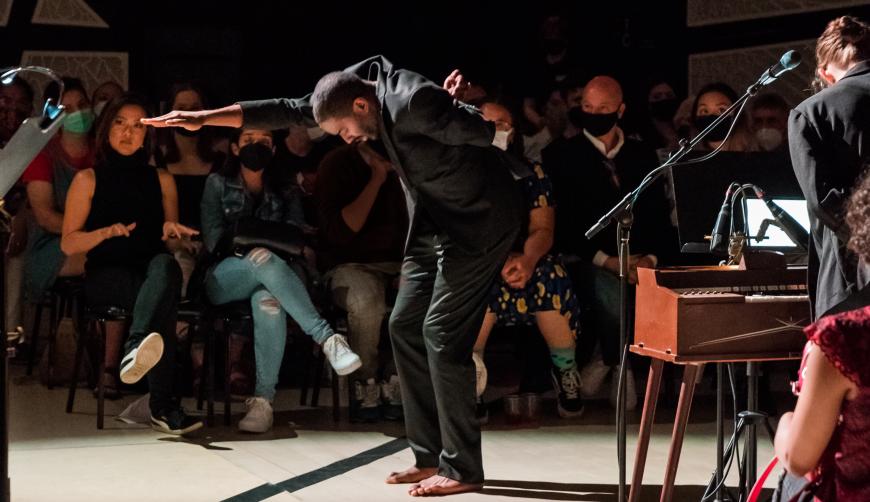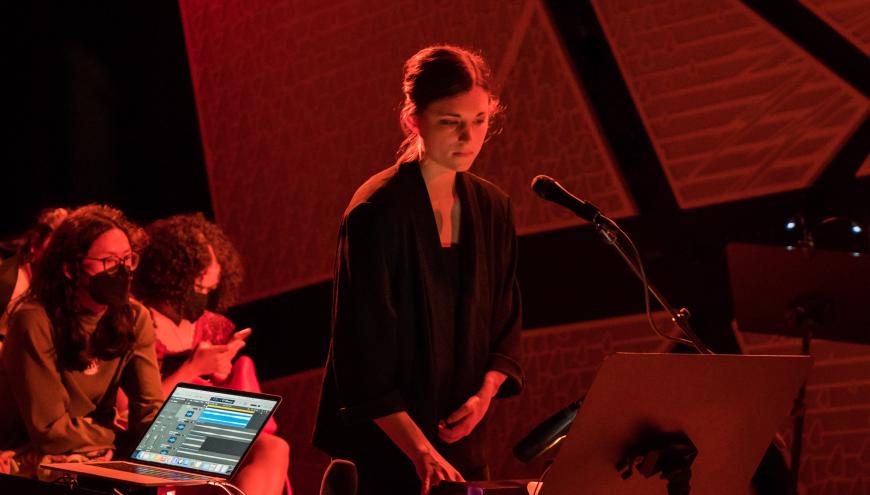
In their solo practices, composer Molly Joyce and choreographer Jerron Herman are artists operating at the vanguard of accessibility and disability aesthetics. Together, their practices become only more potent, creating resonant works that occupy new forms.
This is true of Joyce and Herman’s latest collaboration, Left and Right, which will grace the stage of the Nimoy Theater on May 3, presented by UCLA’s Center for the Art of Performance. Originally conceived as a video work for Brooklyn’s National Sawdust in 2021, Left and Right has now been staged by director Austin Regan; this will be its third live presentation (following 2022 performances in New York and Belgium).
“Jerron and I had worked on two or three pieces together before and had a great ongoing collaboration and working relationship,” Joyce shared in a recent chat. “I love working with dance and am always looking for opportunities to [collaborate with] him.”

Across three movements of song, dance, and poetry, Left and Right examines prevailing mythologies and cultural values around the two sides of the human body. Herman explained this focus in a recent conversation. (For context: Both Joyce and Herman have impaired left sides, though Herman’s is congenital from cerebral palsy and Joyce’s was acquired in a car accident.)
“While [this piece is grounded] in our personal experiences [with our] shared left sides, it is really abstracting how the historical, cultural, and even spiritual realities around the left side [have been seen] throughout history,” Herman said. “That’s something that’s important to the continuation of disability arts. It’s not just about personal narratives. How do these stories already exist in history, culture, and in our thinking?”
Left and Right’s original video form resists easy formal categorization. In centering accessibility, the work allows for a multitude of pathways through it. The audio captioning, designed as both “a bridge for perception and accessibility and an aesthetic poetic element,” charts a resonant path between the music and the dance.
The language the piece creates is deliberately rhizomatic — streams of visual and sonic data flow around each other, alternately overlapping and diverging. This contributes beautifully to the work’s immersive sense of world-building. But how do you translate that to a live performance?
Joyce explained: “Jerron and Austin met me in Omaha … for a weeklong workshop, and it was a really helpful time. We kept the three sections of the piece roughly as they were but decided, firstly, to make the staging a big part of it — having the audience face each other and play with the idea of choosing a side. Our sign language interpreter is also [activated in that staging].
“We also added some opening vignettes to each section, diving back into some of the research we had done around the [main themes of the work]. And after the first two sections, the projectionist will help us poll the audience, posing some of the questions we were exploring to them as well.”

These expansions have been rooted in Left and Right’s thematic content. Herman explained: “Throughout the iterations, there’s been a building of what disability scholar Kevin Gotkin calls ‘access ecology.’ [He says] the procedure of understanding and disseminating disability art is itself iterative, itself dictated by change and by responsiveness.”
Both Joyce and Herman also remarked on how their relationships to Left and Right have evolved. Joyce has increasingly embraced accelerometers and other adaptive and wearable musical technologies in her performance, while Herman spoke of how the added vignettes have given his choreography new inflection.
Friday’s audience will experience the show’s latest iteration. But as Joyce, Herman, and their collaborators continue to live in the work, it will likely continue to grow.




